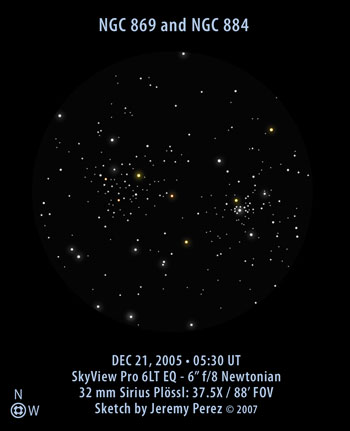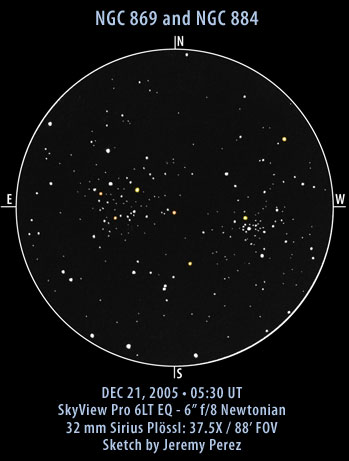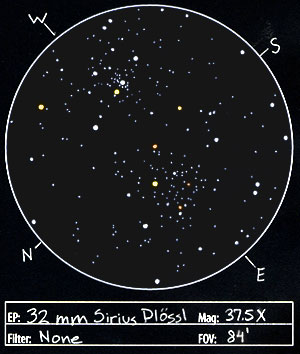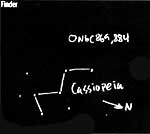
Digital Version
Click image for larger version

Pencil Version
Sketch Refinement - August 4, 2006
This is another sketch that I ended up refining recently. I wanted to make the weights of the fainter stars less bold to provide a better sense of variation in stellar magnitude that is apparent through the eyepiece. This isn't a new observation, just a redraw. I traced the original (holding up to a well-lit window :D ) and then put a bigger spread on boldness by plotting more delicate faint stars.
[edit July 14, 2008: Note that I've added a digital version of the sketch at the top. I'm keeping the original redraw here as well, since I like it for other reasons.]

Observation Notes:
 I've been observing this pair of clusters on a regular basis since I first started messing around my telescope. The first time I checked them out, I was struck by a trail of stars that arcs away to the north, like a fishing line. They are great in binoculars too of course. But it's always nice to pick them out naked-eye. Although I have trouble with astigmatism on individual stars, I am able to make out the two clusters and their orientation without optical aid under a nice, dark sky. All this time, I've been holding off making a sketch, because I knew it was going to be a toughie.
I've been observing this pair of clusters on a regular basis since I first started messing around my telescope. The first time I checked them out, I was struck by a trail of stars that arcs away to the north, like a fishing line. They are great in binoculars too of course. But it's always nice to pick them out naked-eye. Although I have trouble with astigmatism on individual stars, I am able to make out the two clusters and their orientation without optical aid under a nice, dark sky. All this time, I've been holding off making a sketch, because I knew it was going to be a toughie.
Well, this night, I finally went for it. I made the observation from my front yard after most of the neighborhood Christmas lights had been mercifully shut down--especially Santa's After-hours Sweatshop next door. The Double Cluster in Perseus is a beauty and fits perfectly in the 1.4° true field of view provided by my 32 mm plössl. There is a little heiroglyphic character at the heart of NGC 869 that always catches my eye. And the orange and yellow-orange stars pop out right away. Both clusters are roughly circular, with NGC 869 having a brighter, more condensed core, while NGC 884 is looser. The sketch was tough. I nailed down the brightest stars--about 16 of them. Then I started on the core of NGC 869. After that, I worked clockwise from about the 11:00 position for the rest of the view. The moon started to rise about the time I was in the middle of NGC 884. Phew! It was tight timing. Discerning the colored stars I saw at the beginning was more difficult afterward. It was still hard to see color, even after staring at the moonlit house siding to restore photopic vision (as if I lost any of it in this scintillating realm of stray light). The stars I did finally note seem to match up well with astrophotograph comparisons I made afterward. OK, except for the yellow star I marked in the middle of NGC 884 that should just be white apparently...
Factoids:
NGC 869 lies about 7100 light years away with NGC 884 a bit further at 7400 light years. NGC 869 is estimated at 5.6 million years old and NGC 884 at 3.2 million years according to Sky Catalog 2000. They are approaching us at 22 and 21 km/sec. The association was catalogued by Hipparcos in 130 B.C.
| Subject | NGC 869 (h Persei); NGC 884 (chi Persei) |
| Classification | NGC 869: Open Cluster (I 3 r) NGC 884: Open Cluster (I 3 r) |
| Position | Perseus: NGC 869 [RA: 02:19:03.8 / Dec: +57:08:06]* NGC 884 [RA: 02:22:32.1 / Dec: +57:08:39] |
| Size* | NGC 869: 29'; NGC 884: 29' |
| Brightness* | NGC 869: 5.3; NGC 884: 6.1 |
| Date/Time | December 20 - 10:30 PM MST |
| Observing Loc. | Flagstaff, AZ - Home |
| Instrument | Orion SVP 6LT f/8 Reflector (150 mm dia./1200 mm F/L) |
| Eyepieces/Mag. | 32 mm (37.5X) |
| Seeing | 5/10 Pickering |
| Transparency | Mag 5.8 NELM |
| Sources | SEDS, NGC-IC Project |
* Based on published data.





I am just stunned as to how nice your sketches are.Can't wait to see more!.